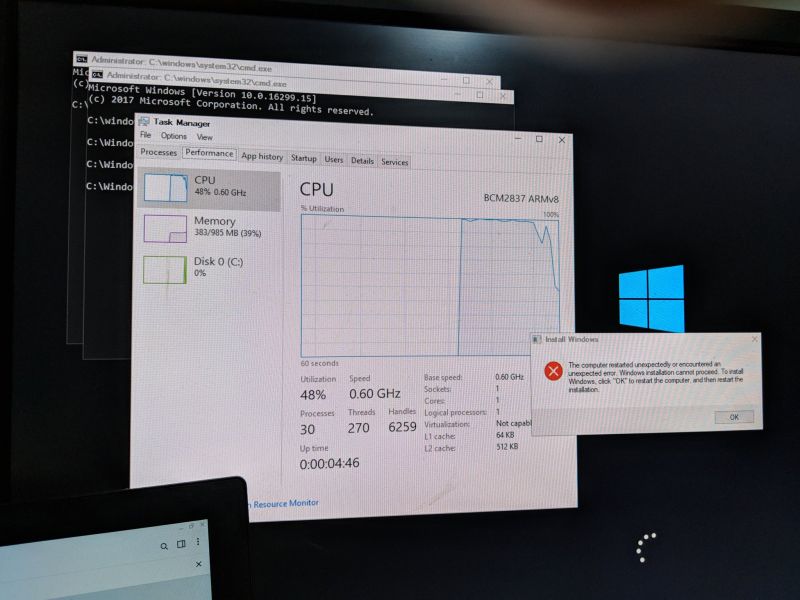Ranter
Join devRant
Do all the things like
++ or -- rants, post your own rants, comment on others' rants and build your customized dev avatar
Sign Up
Pipeless API

From the creators of devRant, Pipeless lets you power real-time personalized recommendations and activity feeds using a simple API
Learn More
Comments
-
MS just won't be able to create hardware on that level. Windows on the other hand has always been multi platform, but nothing except x86 succeeded because customers don't want to throw away their software or live with shitty emulations.
Also, Apple's stuff does revolve around the ARM ISA, the tooling alone is reason enough, and they hold a perpetual licence to the ISA. Which means that Apple is ARM compatible, just the execution is better. Apple hardware is already incompatible just to sell it at twice its worth.
With AMD in full swing, we're likely to get 5W TDP x86 notebook CPUs by 2022 with Zen3 or Zen4. Intel direly needs to get its shit together with their fab processes.
@jespersh Risc5 is out of question because no ecosystem; it's instead aimed at embedded microcontrollers. -
@Jilano That's a big mistake. In embedded, companies like Samsung are already looking into Risc5, and quadrupling the ARM licences will only spur that.
-
My only amendment is that I think it'll be a lot sooner than 5 years. I suspect they're starting those projects already.
-
And actually, Microsoft was leading the way long before Apple - Windows 10 on ARM exists (MS cooperating with Qualcomm for ARM chips), and you can buy devices. It's just that nobody does that because they suck.
The performance sucks because Qualcomm ARMs aren't on par with Apple's in-house chips, the battery life isn't what had been expected, the software compatibility is bad, and you can only emulate x86-32 SW because Intel had shot down x86-64 emulation before it had even started. Also, Windows 10 on ARM looks like more of the Windows RT disaster.
In short, Microsoft has shown Apple a lot about how not to do it.
Remmber also that Apple's ARM laptops only have to beat outdated Intel CPUs (because Apple hardware is both expensive AND outdated) while ARM Windows laptops have to compete against current Intel and, inceasingly, AMD CPUs. -
I don't have too much knowledge of CPU architecture, so I can't really judge them.
From what I've heard ARM is supposed to be great.
The only thing I am worried about is that ARM is for sale... And Nvidia might end up buying them. Please no.
https://arstechnica.com/gadgets/... -
@pxeger ARM has SIMD, it's called "Neon": https://developer.arm.com/architect...
ARM has also FP instructions: https://developer.arm.com/documenta... -
@pxeger RISC/CISC isn't what it was 30 years ago. The distinction has become a lot more blurred - on both sides of the fence.
-
@Fast-Nop
The difference anymore boils down to "do you solve this problem with microcode or silicon?" -
@SortOfTested Actually, x86 CISC CPUs are internal RISC CPUs these days. They split the complex CISC instructions into simpler internal ones (the microcode) which are actually executed. The CISC instruction set is just the external interface.
On the other hand, RISC CPUs have gained more complex instructions like FP and Neon. For ARM Cortex-M in particular, even the opcode length isn't constant because their Thumb-2 is a mixed 16/32 bit instruction set.
That's because Thumb-1 (16 bit only) had a performance problem while ARM-32 (32 bit only) had a problem with the code size ballooning up. Thumb-2 remedies both problems, but isn't classic RISC.
Related Rants
-
 mcminnra10"Python is such a hard language. It has so many rules" - Undergraduate Student who sent out mass email to the ...
mcminnra10"Python is such a hard language. It has so many rules" - Undergraduate Student who sent out mass email to the ... -
 DRSDavidSoft11
DRSDavidSoft11 Prepare to get your MIND BLOWN:
They have successfully got Windows 10 ARM to boot on a Raspberry Pi 3 with a ...
Prepare to get your MIND BLOWN:
They have successfully got Windows 10 ARM to boot on a Raspberry Pi 3 with a ... -
 j4cobgarby1Woah, did you know some of the older arm processors could execute java bytecode directly on the hardware?
j4cobgarby1Woah, did you know some of the older arm processors could execute java bytecode directly on the hardware?

ARM people, a posit, not mine, but interesting thought experiment:
If apple is successful at ARM, we may see in 5ish years the desktop/laptop market flip in an effort to chase. MS sees the custom silicon, creates an MS proprietary ARM to compete with Apple ARM. Now ARM is mostly locked down into these two options and nothing runs on both sets of silicon, or any other silicon. ARM becomes closed AF.
Slim possibility that Intel and AMD jump on the ARM bandwagon and ship their own silicon that's a little more open.
Thoughts?
question
arm army
arm
riscy
low power